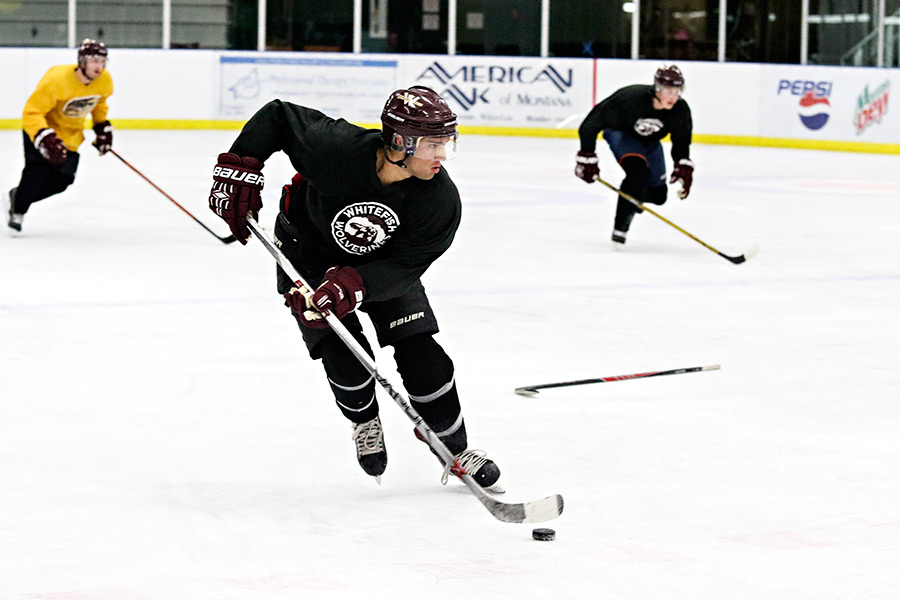On a recent warm morning, Jazmyne Beck laced up her skates at the Stumptown Ice Den in Whitefish and greeted Chad Goodwin, who coaches hockey players in power skating. She groaned about her tired legs but skated out onto the empty ice, where Goodwin would shortly join her for a morning practice. Beck made huge, gentle arcs across the rink, pushing her hockey stick across the ice and warming up not just for the day’s work but for a summer of training.
In years past, the ice den would likely be closed by now, on hiatus until cooler fall temperatures roll in. But with new management by the Whitefish Sports Facilities Foundation and new equipment that will help effectively regulate the ice’s temperature, the rink will stay open through summer’s hottest months.
Beck left Kalispell two years ago to attend the Warner Hockey School, located in the tiny town of Warner, Alberta, hoping to improve her chances of making it onto a good college team. For Beck and other local athletes, many of whom have tryouts during the summer, these upcoming weeks of ice time could make all the difference.
“For me, I really don’t have an off-season,” Beck said. “Athletes get better during the off-season.”
Keeping an enormous slab of ice cooled between 18 and 19 degrees Fahrenheit through three months of fluctuating, hot, and humid weather is as Sisyphean a task as they come. This year, though, thanks to a combination of fundraising efforts by the foundation and TIF funds allocated from the City of Whitefish, management has installed over $50,000 worth of programmable logic controls to make that undertaking feasible for the first time in the rink’s history.
“This came about because of system failures last summer,” Gregg Esakoff, a WSFF board director, said, referring to mechanical issues with the compressors that regulate the ice, which put a strain on operations during the August summer camp.
The PLC, as the new system is collectively referred to, uses some 130 sensors to constantly monitor nearly every component of the chilling system, from ambient air temperature to refrigerator leaks, and then logs that minute information electronically.
“This thing does what 20 guys would do if they stayed in this room and looked at everything every hundredth of a second,” Esakoff said of an enormous switchboard and a tangle of wires in the mechanical room. “This is NHL-type stuff.”
Before the PLC, rink manager Greg Harms would keep records manually, taking paper logs every three hours, a lacking approach when the whole system can fail within minutes and run up thousands of dollars of repair fees.
“The PLC allows us to remotely monitor small problems before they become big, and follow trends,” Harms said.
Arena Products and Services, a chilling service company, will also have access to the PLC’s records. Last summer, the Colorado-based company had to dispatch repairmen to Montana on the rink’s dime. Data from the PLC will ideally allow those experts to stay in Colorado, guiding either Harms or local repairmen through basic fixes.
“This is huge,” Harms said. “It’s a complicated system to run an ice rink, and the PLC helps tie it all together.”
The rink has a low emissivity ceiling, installed last summer, which reflects cold radiating from the ice back to the rink and casts back heat beating down from the outside. The evaporative condenser, also installed recently, is another piece of the puzzle – the machine dispels the energy of hot air inside the rink by evaporating water.
The foundation has organized a full roster of summer programming for people of all skill levels and interests. In collaboration with the Glacier Skate Academy, where Goodwin is the Figure Skating Director, a six-week Learn to Skate program kicked off last week. More hockey, figure skating, and power skating camps will start following June 27, when the rink reopens after two weeks set aside for ice maintenance and repairs. One notable new summer event is a NHL prospect camp, which will offer 15 to 17-year-old players the opportunity to train with the NHL draft and Western Hockey League tryouts in mind.
Summer programming also extends beyond the ice. On July 20, Dr. Saul Miller, a sports psychologist, performance consultant, and the author of “Hockey Tough,” will present a lecture at the O’Shaughnessy Center.
Ultimately, the WSFF board members hope that the profits earned from renting out the rink and running summer programs will not just offset the cost of summer operation, but be more cost-effective than letting the building sit empty for months.
“I think it’ll be a big draw for the summer and shoulder seasons,” Goodwin said.
